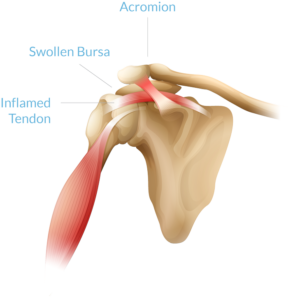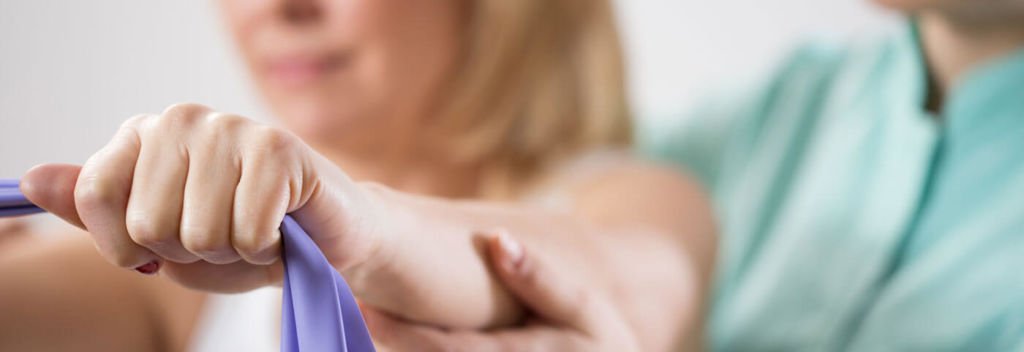
Arthroscopic Shoulder Surgery (Acromioplasty) Recovery
Arthroscopic subacromial decompression (ASAD) is a surgical procedure with the goal of relieving shoulder pain.
One of the most common causes of pain is shoulder impingement, which is a condition where the tendons in the rotator cuffs are compressed during shoulder movements. This can result in pain during movements due to injury to the shoulder tendons and bursa.
The bursa, a sac filled with lubricating fluid, is located between tissues and the skin. Its job is to decrease rubbing, friction, and irritation during movements.
Other surfaces and tissues may also be addressed in arthroscopic shoulder surgery.
Arthroscopic Shoulder Surgery Recovery

Physical Therapy
Physical therapy is advised to optimize your road to recovery. You will be seen by a physical therapist the day after your surgery to:
- Change your dressings
- Take initial measurements
- Learn an initial home exercise program
At this visit, your physical therapist will review information about what to expect during your arthroscopic shoulder surgery recovery, how to take care of your incisions, and how to manage your pain. You’ll receive handouts outlining everything that the physical therapist reviews with you.
Physical therapy appointments will be scheduled two times per week for approximately 6 to 8 weeks.
Using a Sling
After surgery, you’ll be placed in a sling with a post-operative abduction pillow.
You should plan to wear this sling for two weeks during the day and when sleeping at night. After the first two weeks of your arthroscopic shoulder surgery recovery, a short weaning period may be prescribed.
Returning to Work & Daily Activities
Most people can get back to desk work, school, or sedentary activity three to five days after surgery.
If your right shoulder has been operated on, it may be up to two weeks before the arm is strong enough to shift, steer and drive safely. For heavy work, it may take four to six weeks before the arm is strong enough to allow for working. You should never drive or operate heavy machinery if you are using prescription pain relievers.
Returning to Sports
Approximately four weeks after surgery, patients typically begin to perform higher-level activities during physical therapy visits.
With the physical therapist’s guidance at six weeks, you will begin the gradual transition back to your sport. However, your surgeon will make the final decision about your full return to your sport.
Week-by-Week Rehabilitation

Weeks 0 to 2
You’ll be required to use your sling with the abduction pillow during the day and while sleeping at night. You may remove the sling for showering, dressing, and exercises only.
Range of Motion (ROM)
- Flexion (bending) to your tolerance
- External rotations (ER) and internal rotations (IR) at 45 degrees abduction to 30 degrees
- Active assistive range of motion (AAROM) can begin on day 7
Shoulder Rehab Exercises
- Pendulums
- Ball squeezes
- ROM for elbow, forearm, and hand
- Gentle scapular retraction
- Submaximal isometrics
- Static perturbations in scaption (scapular plane elevation)
- AAROM: wand and pulleys
Weeks 2 to 4
Discontinue the use of your sling at week two or wean as needed.
Range of Motion (ROM)
- Flexion within normal limits (WNL)
- ER and IR at 45 degrees abduction to WNL
- ER and IR at 90 degrees abduction to 45 degrees
- Active range of motion (AROM) can begin at day 14
Shoulder Rehab Exercises
- Continue the above exercises and all passive and active ROM
- Prone extension, rows, and horizontal abduction as tolerated
- TheraBand IR and ER in scaption
- Upper body ergometer (UBE) may begin at day 21 (3 weeks)
- AROM: forward flexion in scaption with ER
- Lower trap strength work progressing from side lying to standing
- Side-lying ER
- Initiate low-level closed kinetic chain (CKC)
- Example: wall ball
- Static perturbations at 110 degrees flexion
Weeks 4 to 6
Range of Motion (ROM)
- Full bilateral ROM is expected
Shoulder Rehab Exercises
- Continue exercises from above
- Bicep curls and triceps kickbacks
- Initiate moderate-level CKC
- Example: wall push-ups
- TheraBand IR/ER at 45 degrees, progressing to 90 degrees (pending shoulder mechanics)
- Diagonals pending shoulder mechanics
Weeks 6 to 8
During these weeks, you should have no restrictions with activities of daily living (ADLs).
Shoulder Rehab Exercises
- Continue above exercises
- Initiate gentle plyometrics only if good shoulder mechanics are present
- Initiate dynamic perturbations at week six
- Initiate higher-level CKCs
- Example: push-ups on a table
Weeks 8+
Shoulder Rehab Exercises
- Continue progression for functional strengthening
- Begin Access Acceleration or a similar fitness training program at week 16
- Begin yoga therapy and heavy upper body activities like swimming and racquet sports at week 20
Clearance from Your Surgeon
You may return to your sport once return to play testing is completed and passed at week 12+.

